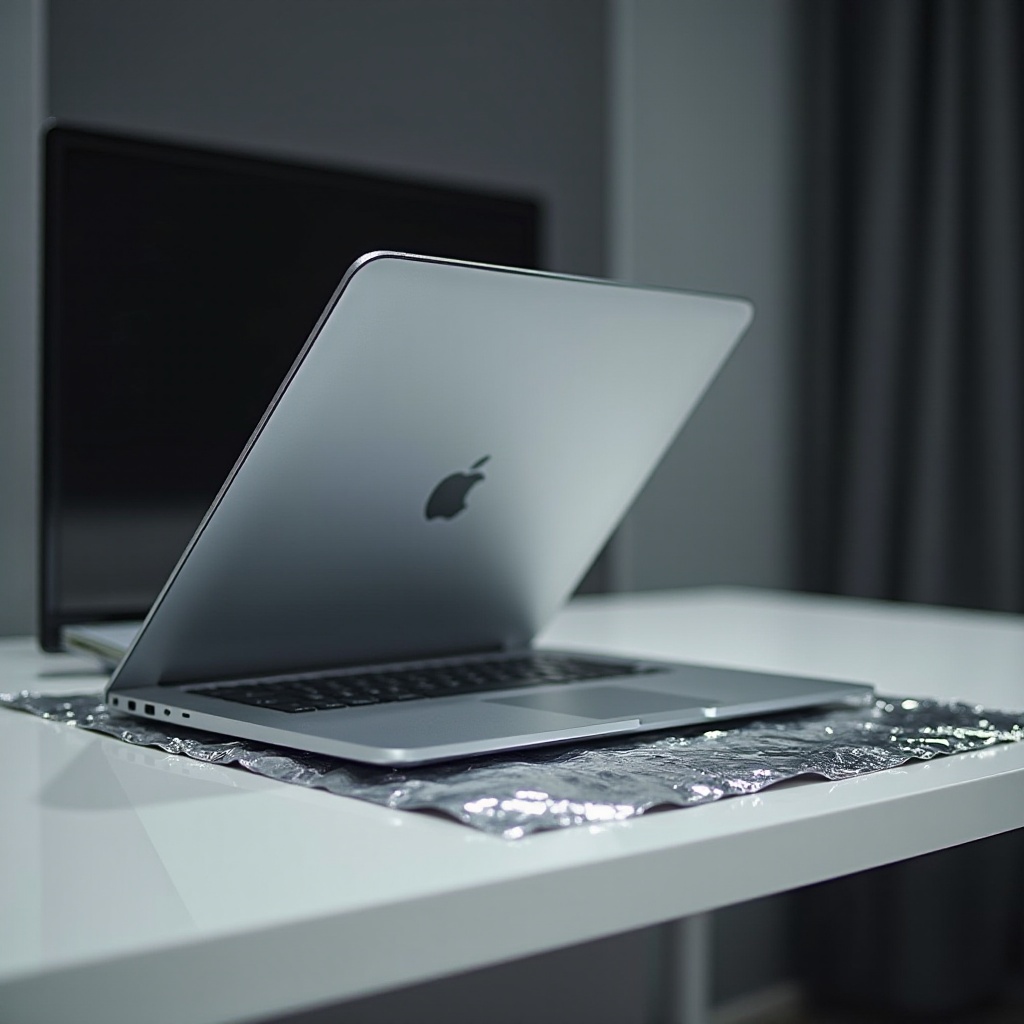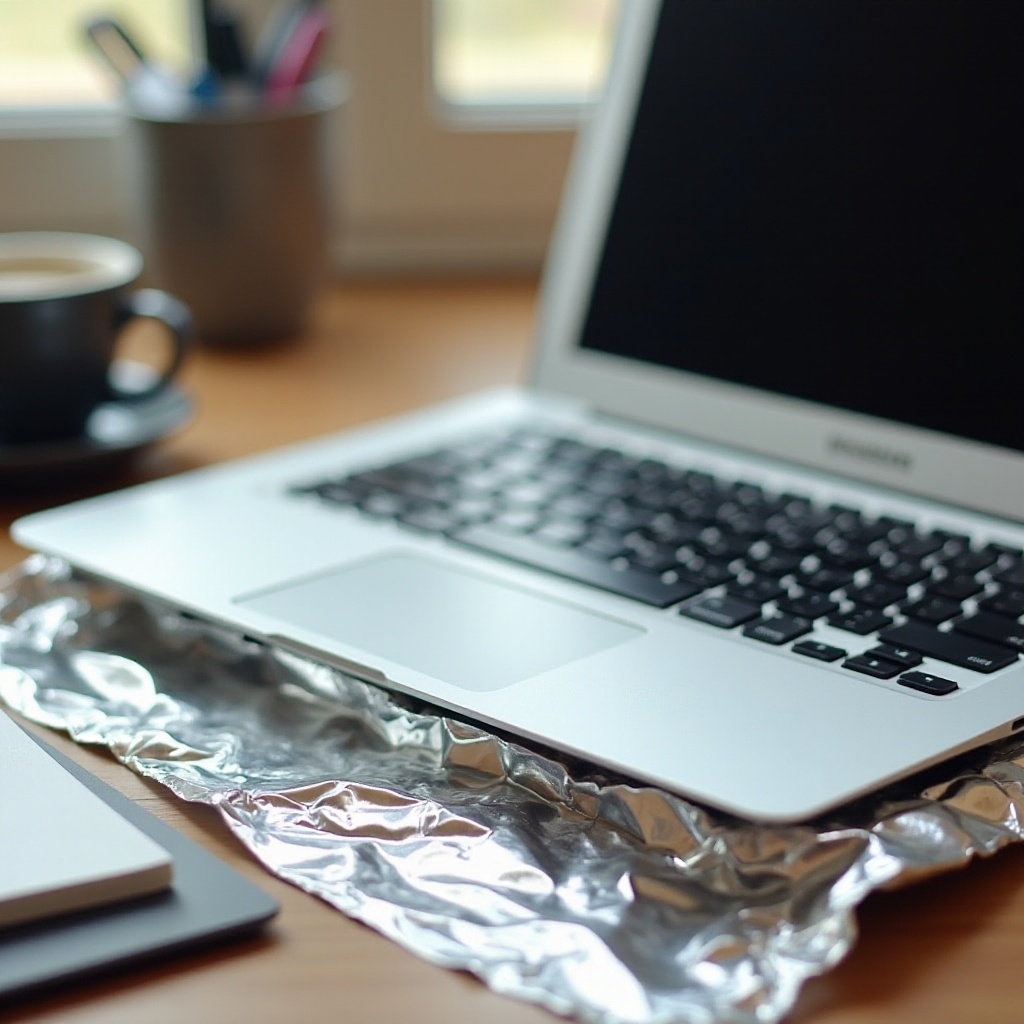Introduction
You’re using your laptop, and it starts heating up. You’ve heard from a friend or seen a quick tip online suggesting that putting aluminum foil under your laptop might help with cooling. The idea may sound plausible, but is it safe or effective? In this blog, we’ll explore the actual impact of placing aluminum foil under your laptop, examine the science behind this theory, and consider what experts have to say. By the end, you’ll know whether this is a hack worth trying or one to avoid and what safer alternatives might better serve your laptop cooling needs.

Understanding Laptop Cooling Systems
Laptops, being compact devices, often face challenges in heat dissipation. The cooling system of a laptop typically includes fans, heat sinks, and thermal paste, all working together to manage the temperature of the internal components. The central processing unit (CPU) and graphics processing unit (GPU) are particularly susceptible to overheating due to their high-performance demands.
A typical laptop’s cooling mechanism involves drawing cool air in through vents and pushing warm air out. This ongoing air circulation helps maintain optimal operating temperatures. Besides, modern laptops come with built-in sensors that monitor heat and adjust fan speeds accordingly. The position of your laptop and its ventilation system plays a crucial role in how effectively heat is managed. Placing the laptop on soft surfaces like blankets can obstruct the vents, leading to overheating.
Given this context, it’s easy to see why someone might reach for a quick fix like aluminum foil. However, before diving into theories, it’s crucial to understand how such interventions can interfere with these conventional cooling mechanisms.

The Theory Behind Using Aluminum Foil
Aluminum foil is a common household item with excellent thermal conductive properties. The theory behind using it under a laptop is based on its ability to reflect and possibly dissipate heat. The idea is that aluminum foil could either direct heat away from the laptop or spread it more evenly across its surface to enhance air circulation around the device.
In theory, placing something with high thermal conductivity like aluminum foil could help manage heat more effectively than a soft, insulating surface. Moreover, some suggest that shaping the foil into a makeshift stand allows better air flow underneath the laptop. However, theories often differ significantly from real-world outcomes, and it’s crucial to understand the potential risks involved.
Risks and Potential Damage
While the theory may sound convincing, putting aluminum foil under your laptop can pose several risks and potentially damage your device:
-
Short-Circuiting: Aluminum is a conductive material. If it comes into contact with any exposed electrical components of your laptop, it could potentially cause a short circuit, leading to significant damage.
-
Insufficient Cooling: Unlike the advanced cooling mechanisms in computers designed to manage thermal output efficiently, a piece of aluminum foil doesn’t have the capacity to mitigate high heat levels effectively. In fact, it might even reflect back the heat, trapping more warmth underneath.
-
Static Electricity: Aluminum foil can carry static electricity. Static discharge can damage electronic circuits and components within your laptop, potentially leading to malfunctions or permanent damage.
-
Fire Hazard: In extreme cases, using inappropriate materials to manage heat can pose a fire risk. While this might seem far-fetched, laptops generate significant heat, and any improper handling could potentially escalate into a hazard.
Carefully consider these risks before adopting a solution that, while seemingly simple and cheap, may result in more harm than good.
Real-World Testing and Results
Let’s delve into some real-world testing of using aluminum foil under a laptop to understand if the claims hold water. Several tech enthusiasts and YouTube reviewers have experimented with this method. Typically, these tests involve measuring the laptop’s temperature before and after placing the foil.
In many instances, results indicate either negligible temperature changes or even slight increases in heat. Tests showed that without good ventilation designed specifically for heat dissipation, aluminum foil merely offers a reflective surface, which can trap heat instead of dispersing it effectively. A common observation across these tests is that the foil does not significantly improve laptop cooling and sometimes exacerbates overheating.
These experiments make it clear that good intentions may not translate into practical results when it comes to ad-hoc cooling fixes. This leads us to consider the opinions and advice from experts in laptop and thermal management.
Expert Opinions and Recommendations
Experts in computer hardware and thermal management generally advise against using aluminum foil under laptops. According to professionals, modern laptops are engineered with optimized cooling systems that work best under normal, unobstructed conditions. Adding an unusual layer like aluminum foil can disrupt airflow and exacerbate thermal issues.
Tech experts often emphasize the importance of keeping vents clear and ensuring the laptop is placed on a hard, flat surface to facilitate natural cooling. Cooling pads designed specifically for laptops, equipped with additional fans, are recommended as more effective tools for managing heat.
Experts underscore that DIY solutions involving conductive materials might lead to unintended damage and potential safety hazards. Their guidance highlights safer and more effective methods tailored to laptop design.

Safer Alternatives for Laptop Cooling
Instead of relying on aluminum foil, consider these safer alternatives to effectively cool your laptop:
-
Cooling Pads: Use cooling pads designed with built-in fans placed under your laptop. These pads enhance airflow and help dissipate heat more efficiently.
-
Laptop Stands: Elevate your laptop with a stand to improve air circulation. Many stands are designed to keep laptops cool by allowing better airflow underneath.
-
Regular Cleaning: Dust and debris can block vents and fans. Regularly clean your laptop’s cooling system to maintain optimal performance.
-
Undervolting: Reducing the voltage supplied to your CPU can lower its heat output. Undertake this process cautiously and follow guidelines meticulously to avoid damage.
These methods are specifically tested and recommended for keeping laptops cool without risking damage.
Conclusion
Putting aluminum foil under your laptop is not a recommended practice for cooling. Despite its theoretical merits, the actual risks and potential harm far outweigh any minimal benefits. It’s better to rely on specialized cooling pads or stands and ensure your laptop’s built-in ventilation system is unimpeded. Stay informed and choose safe solutions for effective laptop cooling.
Frequently Asked Questions
Can aluminum foil damage my laptop?
Yes, aluminum foil can damage your laptop. Being a conductive material, it can cause short-circuiting, static discharge, and potentially lead to component malfunction.
Are there any benefits to using aluminum foil under a laptop?
There are minimal to no benefits to using aluminum foil under a laptop. It does not significantly improve cooling and may cause more harm than good.
What are the best alternatives to aluminum foil for cooling my laptop?
The best alternatives include using cooling pads with fans, laptop stands to improve air circulation, regular cleaning of the cooling system, and undervolting the CPU. These methods are safer and more effective.